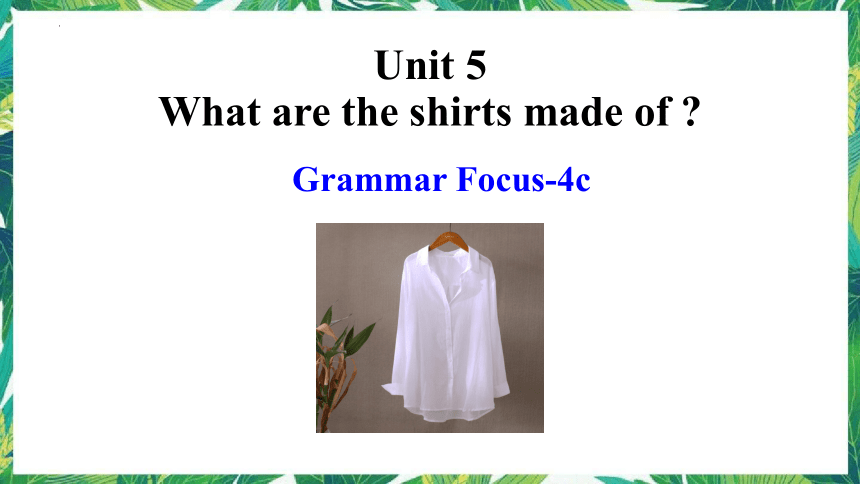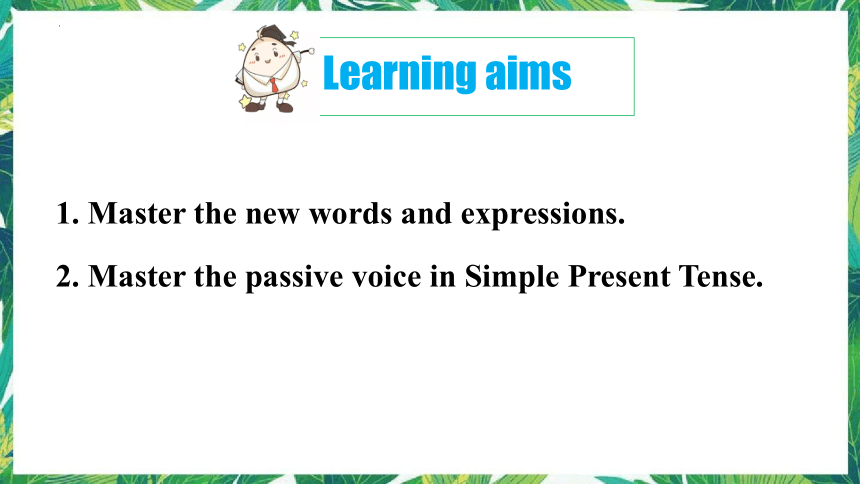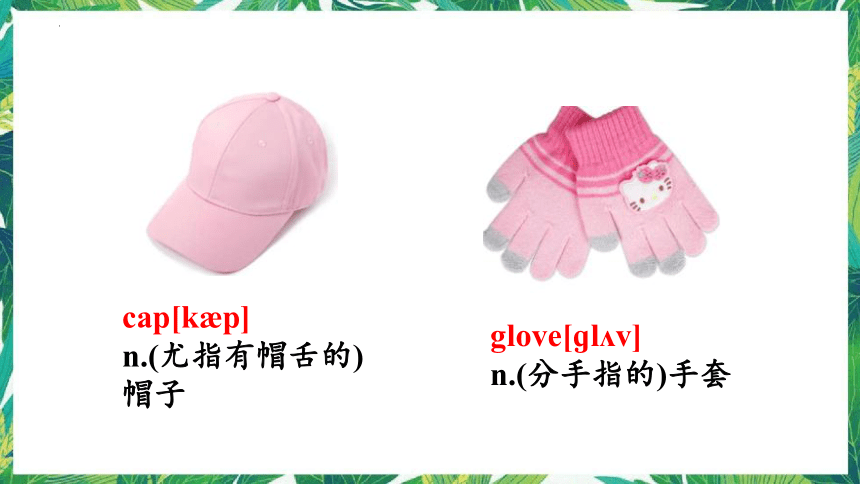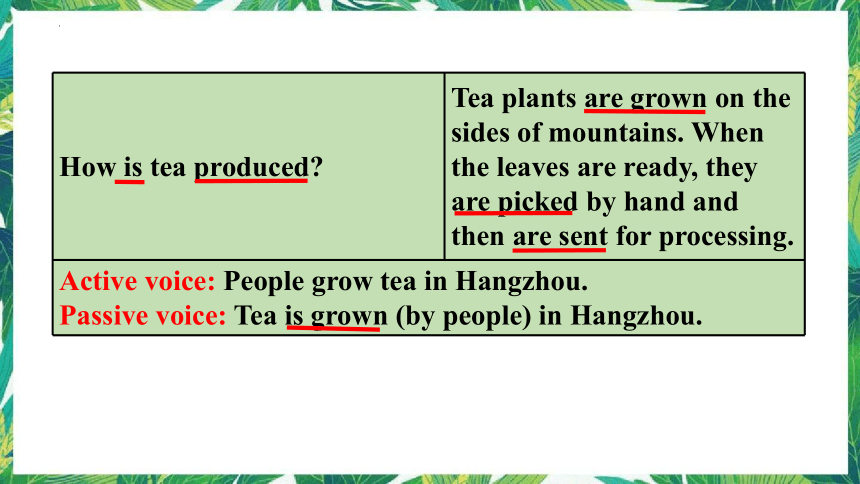Unit5 SectionA Grammar Focus-4c课件 (共18张PPT)
文档属性
| 名称 | Unit5 SectionA Grammar Focus-4c课件 (共18张PPT) |  | |
| 格式 | zip | ||
| 文件大小 | 903.0KB | ||
| 资源类型 | 教案 | ||
| 版本资源 | 人教新目标(Go for it)版 | ||
| 科目 | 英语 | ||
| 更新时间 | 2022-09-24 16:14:21 | ||
图片预览







文档简介
(共18张PPT)
Unit 5
What are the shirts made of
Grammar Focus-4c
Learning aims
1. Master the new words and expressions.
2. Master the passive voice in Simple Present Tense.
New words
boss[b s]
n.老板;上司
Germany [ d rm ni]
德国
surface
[ s rf s]
n.表面;表层
material [m t ri l]
n.材料;原料
traffic [ tr f k]
n.交通;路上行驶的车辆
postman [ po stm n]
n.邮递员
cap[k p]
n.(尤指有帽舌的)帽子
glove[ɡl v]
n.(分手指的)手套
Are your shirts made of cotton Yes, they are. And they
were made in the US.
What’s the model plane made of It’s made of used wood and glass.
Where is tea produced in China It’s produced in many different areas.
Grammar Focus
How is tea produced Tea plants are grown on the sides of mountains. When the leaves are ready, they are picked by hand and then are sent for processing.
Active voice: People grow tea in Hangzhou. Passive voice: Tea is grown (by people) in Hangzhou.
在英语中,动词有两种语态,即主动语态和被动语态。被动语态的基本结构是“助动词 be + 及物动词的过去分词”,其中助动词be有人称、数和时态的变化,其变化规则与be作为连系动 完全一样。
一般现在时的被动语态
1.一般现在时被动语态的各种句式结构
肯定式 主语+am/is/are+过去分词( + by…)
Eg. This meal is made by Tom.
否定式 主语+am/is/are + not +过去分词 (+by…)
Eg. This meal is not made by Tom.
疑问式 Am/Is/Are+主语+过去分词(+ by …)
Eg. Is this meal made by Tom
特殊疑问词+ am/is/are+主语+过去分词(+ by ...)
Eg. What is made by Tom
2.一般现在时中被动语态的基本用法
用法 示例
表示经常性或习惯性发生的被动动作 I am often asked the question by my pupils.
表示近期正在发生的被动动作 These days people are moved by a teacher named Zhang Lili.
描述某种常态化的被动的客观事实 The spaceship is mainly controlled by computer.
强调目前存在的针对行为主体人的被 限制性动作
You aren’t allowed to take photos.
3.主动语态变为被动语态的方法
第一步:将主动语态的宾语改为被动语态的主语;
第二步:将主动语态的谓语改为“be+及物动词的过去
分词”结构;
第三步:将主动语态的主语改为介词by的宾语,放在
谓语之后(有时可省略)。
如图示:
They (主语)grow (谓语)tea (宾语)in the south-east of China.
被动语态:
主动语态:
Tea (主语)is grown (谓语)by them in the south-east of China.
宾变主,把be补
动词跟,变过分(过去分词)
原主by后做宾语(可以省略)
代词宾格要记住
People play football all over the world.
2. The old man on TV tells a story on Sunday.
3. Students listen to the kind teacher carefully.
Football is played all over the world by people.
A story is told by the old man on TV on Sunday.
The kind teacher is listened to by students carefully.
把下列的主动句变为被动句。
宾变主,把be补
动词跟,变过分(过去分词)
原主by后做宾语(可以省略)
代词宾格要记住
4a
Children under 18 ______________ (not allow)
to watch this show without their parents.
2.We ________ (pay) by the boss on the last Friday of each month.
3.A: What language ________ (speak) in Germany
B: Most people speak German, but many can speak English, too.
4.Most of the earth’s surface _________ (cover) by water.
5.The classroom ___________ (clean) by the students every day.
are not allowed
are paid
is spoken
is covered
is cleaned
Germany 德国
German 1.n.德国人,复数Germans
2.n.德语 3.adj.德国(人)的;德语的
on the surface 表面上
Complete the sentences with the correct forms of the verbs in brackets.
allow sb. to do sth. 允许某人做某事
be allowed to do sth.被允许做某事
allow doing sth.允许做某事
4b Rewrite the sentences using the passive
voice.
Farmers plant the tea on the sides of mountains.
The tea is planted on the sides of mountains by farmers.
2. This shop uses the best materials to make dresses.
_________________________________________
________________
3. Careless driving causes many traffic accidents.
________________________________________
_________
The best materials are used to make dresses
by this shop.
Many traffic accidents are caused by Careless driving.
traffic 交通,不可数n.
heavy traffic 交通拥堵
traffic lights交通灯
4. The postman brings letters and postcards to
people’s homes.
______________________________________
_____________________
5. Our family does not use this silver plate very
often.
_______________________________________
___________________________
Letters and postcards are brought to people’s
home by the postman.
This silver plate is not used very often by our
family.
postman 邮递员,复数postmen
4c Ask five classmates about something they are wearing or have in their schoolbags. The list of words below may help you.
pencil, jacket, sweater, T-shirt, shoes,
cap, gloves, ring...
A: What’s your pencil made of
B: It’s made of wood.
A: Where was it made
B: It was made in Shanghai.
Homework
1.Finish 4c. Make your own conversation.
2.Finish the exercises of this part on your exercise book.
Thanks for listening!
Unit 5
What are the shirts made of
Grammar Focus-4c
Learning aims
1. Master the new words and expressions.
2. Master the passive voice in Simple Present Tense.
New words
boss[b s]
n.老板;上司
Germany [ d rm ni]
德国
surface
[ s rf s]
n.表面;表层
material [m t ri l]
n.材料;原料
traffic [ tr f k]
n.交通;路上行驶的车辆
postman [ po stm n]
n.邮递员
cap[k p]
n.(尤指有帽舌的)帽子
glove[ɡl v]
n.(分手指的)手套
Are your shirts made of cotton Yes, they are. And they
were made in the US.
What’s the model plane made of It’s made of used wood and glass.
Where is tea produced in China It’s produced in many different areas.
Grammar Focus
How is tea produced Tea plants are grown on the sides of mountains. When the leaves are ready, they are picked by hand and then are sent for processing.
Active voice: People grow tea in Hangzhou. Passive voice: Tea is grown (by people) in Hangzhou.
在英语中,动词有两种语态,即主动语态和被动语态。被动语态的基本结构是“助动词 be + 及物动词的过去分词”,其中助动词be有人称、数和时态的变化,其变化规则与be作为连系动 完全一样。
一般现在时的被动语态
1.一般现在时被动语态的各种句式结构
肯定式 主语+am/is/are+过去分词( + by…)
Eg. This meal is made by Tom.
否定式 主语+am/is/are + not +过去分词 (+by…)
Eg. This meal is not made by Tom.
疑问式 Am/Is/Are+主语+过去分词(+ by …)
Eg. Is this meal made by Tom
特殊疑问词+ am/is/are+主语+过去分词(+ by ...)
Eg. What is made by Tom
2.一般现在时中被动语态的基本用法
用法 示例
表示经常性或习惯性发生的被动动作 I am often asked the question by my pupils.
表示近期正在发生的被动动作 These days people are moved by a teacher named Zhang Lili.
描述某种常态化的被动的客观事实 The spaceship is mainly controlled by computer.
强调目前存在的针对行为主体人的被 限制性动作
You aren’t allowed to take photos.
3.主动语态变为被动语态的方法
第一步:将主动语态的宾语改为被动语态的主语;
第二步:将主动语态的谓语改为“be+及物动词的过去
分词”结构;
第三步:将主动语态的主语改为介词by的宾语,放在
谓语之后(有时可省略)。
如图示:
They (主语)grow (谓语)tea (宾语)in the south-east of China.
被动语态:
主动语态:
Tea (主语)is grown (谓语)by them in the south-east of China.
宾变主,把be补
动词跟,变过分(过去分词)
原主by后做宾语(可以省略)
代词宾格要记住
People play football all over the world.
2. The old man on TV tells a story on Sunday.
3. Students listen to the kind teacher carefully.
Football is played all over the world by people.
A story is told by the old man on TV on Sunday.
The kind teacher is listened to by students carefully.
把下列的主动句变为被动句。
宾变主,把be补
动词跟,变过分(过去分词)
原主by后做宾语(可以省略)
代词宾格要记住
4a
Children under 18 ______________ (not allow)
to watch this show without their parents.
2.We ________ (pay) by the boss on the last Friday of each month.
3.A: What language ________ (speak) in Germany
B: Most people speak German, but many can speak English, too.
4.Most of the earth’s surface _________ (cover) by water.
5.The classroom ___________ (clean) by the students every day.
are not allowed
are paid
is spoken
is covered
is cleaned
Germany 德国
German 1.n.德国人,复数Germans
2.n.德语 3.adj.德国(人)的;德语的
on the surface 表面上
Complete the sentences with the correct forms of the verbs in brackets.
allow sb. to do sth. 允许某人做某事
be allowed to do sth.被允许做某事
allow doing sth.允许做某事
4b Rewrite the sentences using the passive
voice.
Farmers plant the tea on the sides of mountains.
The tea is planted on the sides of mountains by farmers.
2. This shop uses the best materials to make dresses.
_________________________________________
________________
3. Careless driving causes many traffic accidents.
________________________________________
_________
The best materials are used to make dresses
by this shop.
Many traffic accidents are caused by Careless driving.
traffic 交通,不可数n.
heavy traffic 交通拥堵
traffic lights交通灯
4. The postman brings letters and postcards to
people’s homes.
______________________________________
_____________________
5. Our family does not use this silver plate very
often.
_______________________________________
___________________________
Letters and postcards are brought to people’s
home by the postman.
This silver plate is not used very often by our
family.
postman 邮递员,复数postmen
4c Ask five classmates about something they are wearing or have in their schoolbags. The list of words below may help you.
pencil, jacket, sweater, T-shirt, shoes,
cap, gloves, ring...
A: What’s your pencil made of
B: It’s made of wood.
A: Where was it made
B: It was made in Shanghai.
Homework
1.Finish 4c. Make your own conversation.
2.Finish the exercises of this part on your exercise book.
Thanks for listening!
同课章节目录
- Unit 1 How can we become good learners.
- Section A
- Section B
- Unit 2 I think that mooncakes are delicious!
- Section A
- Section B
- Unit 3 Could you please tell me where the restroom
- Section A
- Section B
- Unit 4 I used to be afraid of the dark.
- Section A
- Section B
- Unit 5 What are the shirts made of?
- Section A
- Section B
- Review of Units 1-5
- Unit 6 When was it invented?
- Section A
- Section B
- Unit 7 Teenagers should be allowed to choose their
- Section A
- Section B
- Unit 8 It must belong to Carla.
- Section A
- Section B
- Unit 9 I like music that I can dance to.
- Section A
- Section B
- Unit 10 You're supposed to shake hands.
- Section A
- Section B
- Review of Units 6-10
- Unit 11 Sad movies make me cry.
- Section A
- Section B
- Unit 12 Life is full of the unexpected
- Section A
- Section B
- Unit 13 We're trying to save the earth!
- Section A
- Section B
- Unit 14 I remember meeting all of you in Grade 7.
- Section A
- Section B
- Review of Units 11-14
